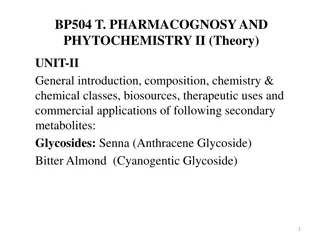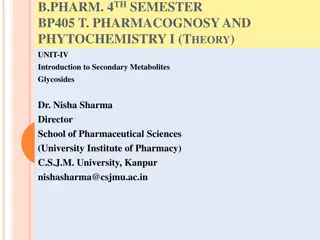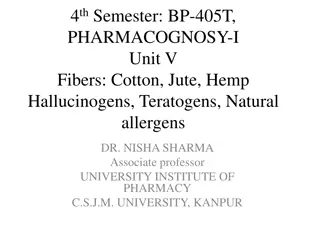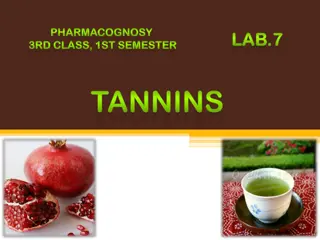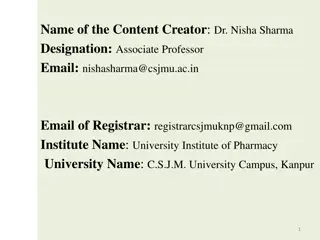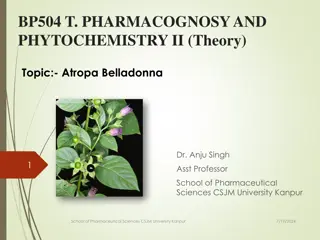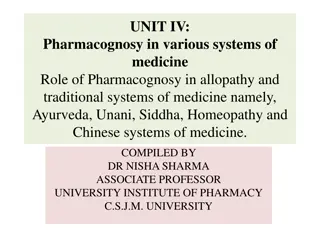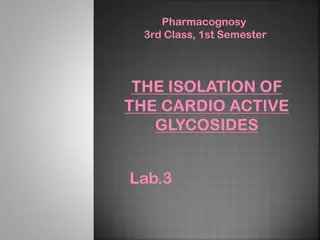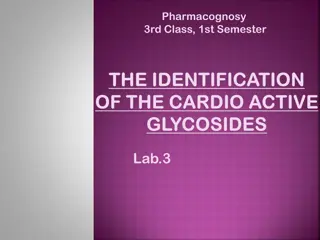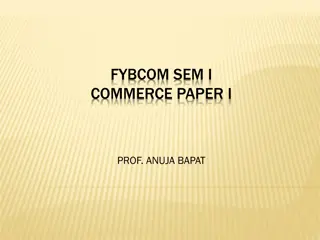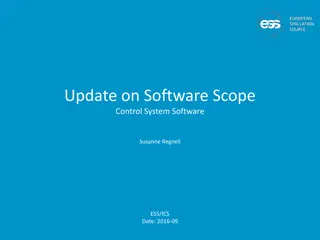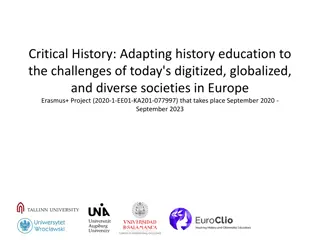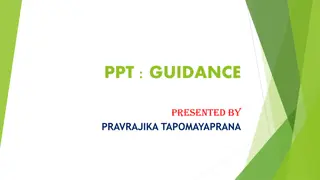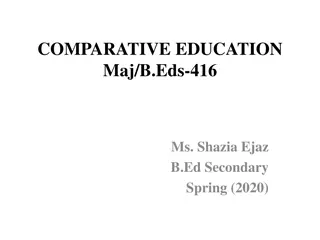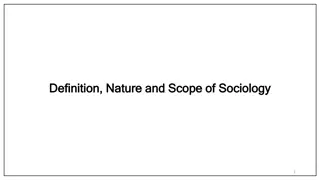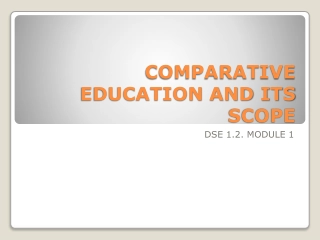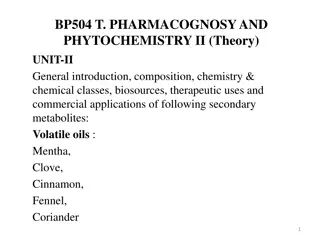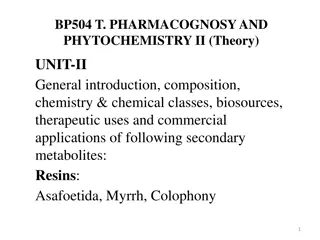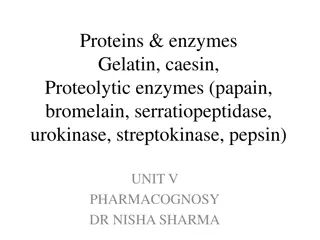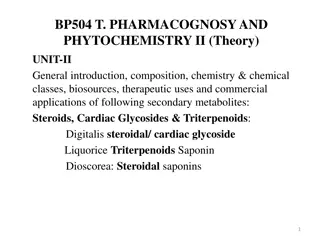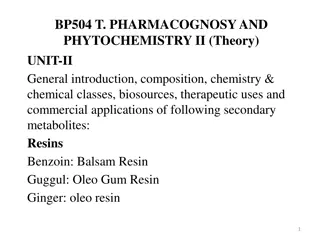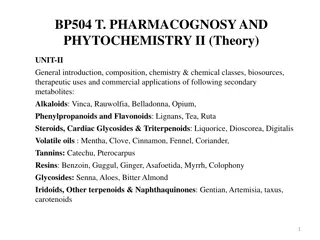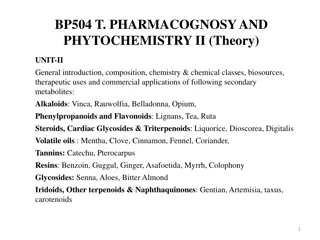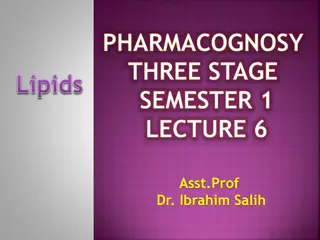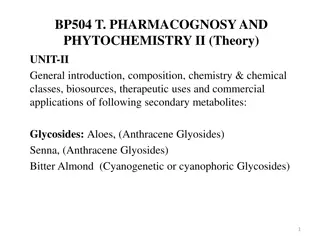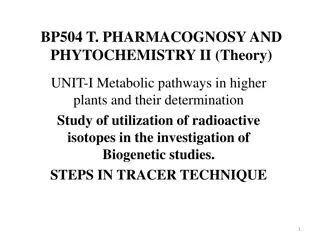History, Development, and Scope of Pharmacognosy
Pharmacognosy is the study of medicinal uses of crude drugs obtained from plants and natural resources. It involves researching physical, chemical, and biological properties of drugs from natural sources. The history of pharmacognosy dates back to prehistoric times, where the use of medicinal plants was recorded through oral transmission. The written history of pharmacognosy is divided into various regions and cultures such as Western medicine, Ayurveda, Unani, African System, Orient, and Greek history. This field has evolved over time, contributing to our understanding of natural remedies and drug sources.
Download Presentation

Please find below an Image/Link to download the presentation.
The content on the website is provided AS IS for your information and personal use only. It may not be sold, licensed, or shared on other websites without obtaining consent from the author. Download presentation by click this link. If you encounter any issues during the download, it is possible that the publisher has removed the file from their server.
E N D
Presentation Transcript
HISTORY, DEVELOPMENT AND SCOPE OF PHRMACOGNOSY Anju Singh School of Pharmaceutical Sciences CSJMU, Kanpur
INTRODUCTION OF PHARMACOGNOSY DEFINITION OF PHARMACOGNOSY Pharmacognosy is the study of the medicinal uses of crude drugs obtained from plants and natural resources. The American Society of Pharmacognosy defines Pharmacognosy as "the study of the physical, chemical, biochemical and biological properties of drugs, drug substances or potential drugs or drug substances of natural origin as well as the search for new drugs from natural sources". The word Pharmacognosy is Greek word derived from two words, Pharmakon means medicine (drug) and Gignosco means to acquire knowledge
Pharmacognosy is complete and systematic study of crude drugs obtained from natural origin like plant, animal and minerals. Pharmacognosy can be defined as branch of science which involves detail study of drugs obtained from natural origin including name, habitat, collection, cultivation, macroscopy, properties, chemical constituents, actions, uses and adulterants. microscopy, physical therapeutic Crude drugs are the drugs, which are obtained form natural sources like plant, animals, minerals & they are used as such as they occur in nature without any processing except, drying & size reduction.
HISTORY OF PHARMACOGNOSY Pre-history The first or beginning of pre-history on use of medicinal plants or herbs or animals, and the place where and how used were not well known, and those information were unwritten for a long time. As a result, the pre-history on herbs was almost lost. However, some information was recorded by oral transmission from generation to generation. Written history The written history has originated which was based on region, religion and culture etc. The written history was divided into the following: 1. The Western medicine 3. The Ayurveda (Indian) 5. The African System 2. The Unani (Islam) 4. The Orient 6. The Greek History
1. The western medicine This is originated in Mesopotamia and Egypt. Mesopotamia is considered as the first origin of human civilization. The Sumerians (peoples of ancient Mesopotamia) developed cuneiform tablet of herbal medicines. Those tablets is preserved in British museum. The Babylonians were aware of the Medicinal effects of a number of plants. Ancient Egyptians possessed a sound knowledge of human anatomy as well as a knowledge of the medicinal uses of many plants and animals.
In Egypt, information had written on paper Papyrus ebers (1600BC). a scroll some 60 feet long and a foot wide it consisted of 800 prescriptions, mentioning 700 drugs. The first pharmacopoeia named London Pharmacopoeia was published in 1618 and then British Pharmacopoeia was published in 1864. 2. The Unani (Islam) This herbal system was developed by Arabian Muslim Ibn Sina (980 1037 AD). He was a prince and ruler. He was a very brilliant pharmacist and physician who wrote a book Kitab-Al-Shifa , means Book of Healing . The book was written on Arabic language. This is a great contribution of Ibn Sina on medical and pharmaceutical sciences.
3. The Ayurveda (Indian, 2500-600 BC): Ayurveda is the term for traditional medicine of ancient India. The word Ayur means Life and veda means The study of that is Study of Life or Science of life. The Ayurvedic writings were divided into three systems: 1) Charaka Samhita, 2) Sushruta Samhita and 3) Astanga samhita. The oldest writing was Charaka Samhita (six to seven century before Christ). The book describes uses of many metallic drugs eg., iron, mercury, sulphur, cupper etc with herbs. In India, the study of the drugs was started about 5000 years ago at the time of the Vedas. Ayrurvedic system (1200 B.C. Ago list with 127 plants.) Charaka, 50 grups of 10 herbs each for illness.(Charak Samhita) Sushruta, 7 groups of 760 herbs based on properties of plants. (Sushruta Samhita)
4. The orient (2700 BC) This is originated from Chinese, Japanese and Tibet etc. The orient herbalism was very old (142 220 BC) and called Kampo . The written documents were made by the King Shen Nung (2700 BC) and Shang (1766 1122 BC) etc. Shen Nung investigated medicinal value of several herbs and written a book Pen T-Sao or native herbal. It contains 365 drugs, one for each day of the year. 5. The African System (Tropical Africa, North and South America): They keep information in their groups or tribes. The information transmitted from one generation to another. These regions are richest sources of medicinal plants and needs to explore for new drug discovery.
6. The Greek History Hippocrates (Father of Medicine, 460-370 BC): He was the first natural doctor who utilized simple remedies such as vinegar, honey, herbs etc in healing. He is also known to have collected and identified a number of medicinal plants. Also deals with anatomy and physiology. Aristotle (384-322 BC): He gave the philosophy of medicine. He listed more than 500 plants of medicinal importance. Theophrastus (340 BC): gave scientific basis of use of plants as medicine. Galen (131-200 AD): a Greek pharmacist-physician. He developed the methods of preparing and compounding medicines by mechanical means of vegetable and animal origin and laid down many formulas contained in a treatise(thesis) of 20 volumes.. He was the originator of the formulae for a cold cream. Paracelsus (1493--1541) to develop mineral salts which might have had the potential of being universal curative agents Dioscorides (40-80 AD) a Greek physician of the1st Century A.D. was the writer of De Materia Medica/ Materia Medica . Here he described 600 medicinal plants, including Belladona, Colchicum, Opium, Hyoscyamus, etc.
DEVELOPMENT OF PHARMACOGNOSY Le'mery (1645-1715), develop an importance method of the extraction with alcohol as an extractant. William Withering in 1785 published an account of some of the medicinal properties of foxglove leaves based on ten years of experimentation. Percolation process was used for the crude drugs. Calumba, an alkaloidal drug, became official in 1788, In 1803, the French pharmacist, Derosne isolated narcotine from opium. In 1806. Sertuerner isolated morphine from opium and its role in leviating pain was recognised. In the next few years, strychnine (1817), emetine (1817), brucine (1819), piperine (1819), quinine (1820) and colchicine (1820) were isolated. The French Pharmacist, Pelletier first reported the isolation of strychnine from ignatius beans and later from nux vomica seeds. A new extraction process for alkaloid was developed by Stass and Otto in 1852.
In the nineteenth century, the term Materia Medica' was used for the subject now known as "Pharmacognosy". While studying Sarsaparilla, it was Seydler, a German scientist, who coined the term "Pharmacognosy" in 1815 in the title of Pharmacognostica". his work "Analecta Pharmacognosy is derived from two Greek words viz. Pharmakon (a drug) and Gignosco (to acquire the knowledge of).
Carolus Linnaeus (1707 1778) classified the plant & introduced the system of naming the plant known as binomial system. Plant Classification was developed by Benthan & Hooker (1862 1863), A.W. Eichler (1883), Engler & Prandtl (1887 1898) In 1865, G. Mendel s important observation on plant hybrids. In Nepal Chandra Nighantu a herbal pharmacopoeia of 278 medicinal plants was initiated by Rana Prime Minister.
Scope of Pharmacognosy Pharmacognosy is important branch of pharmacy which is playing key role in new drug discovery and development by using natural products. Pharmacognosy has given many leads for new drug discovery and development. 2. It is an important link between modern medicine systems (allopathy) and traditional system of medicine. It is part medicinal system which is affordable as well as accessible to common man. As part of integrative system of medicine, pharmacognosy can help to increase effectiveness of modern medicine system
3. It is acting as bridge between pharmacology, medicinal chemistry and pharmacotherapeutics pharmaceutics. It also bridges pharmaceutics with other pharmacy subjects and also 4. More than 60 percent of world population is still using natural product for their primary healthcare needs. Pharmacognosy can provide safe and effective drugs in combination with modern medicine system.
5. Pharmacognosy includes knowledge about safe use of herbal drugs including toxicity, side effects, drug interaction thereby increasing effectiveness of modern medicine. 6. Pharmacognosy is an important link between pharmacology and medicinal chemistry. As a result of rapid development of phytochemistry and pharmacological testing methods in recent years, new plant drugs are finding their way into phytochemicals, rather than in the form of traditional galenical preparations. 7. Pharmacognosy is the base for development of novel medicines. Most of the compounds obtained from natural product serve as prototype or base for development of new drug which are more active and less toxic. medicine as purified
8. By means of pharmacognosy, natural products can be dispensed, formulated and manufactured in dosage forms acceptable to modern system of medicine. 9. There are vast number of plant and animal species which are not studied systematically. 10. Development of pharmacognosy also leads to development of botany, biotechnology, plant genetics, plant pathology, pharmaceutics, pharmacology, phytochemistry and other branches of science. taxonomy, plant
THANK YOU THANK YOU


